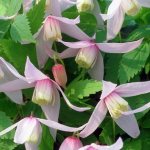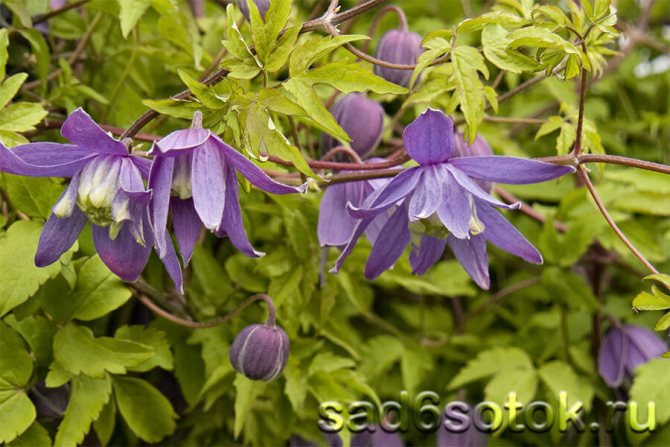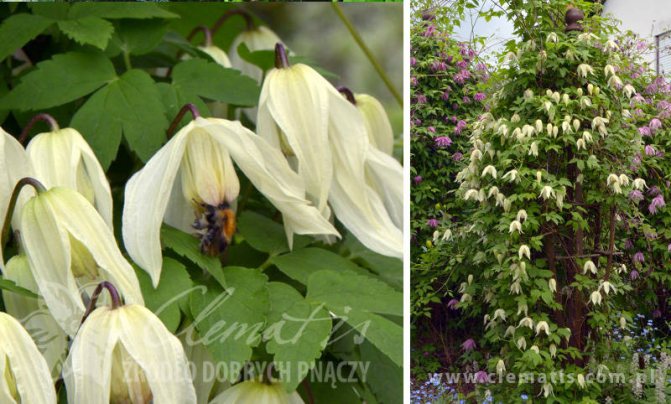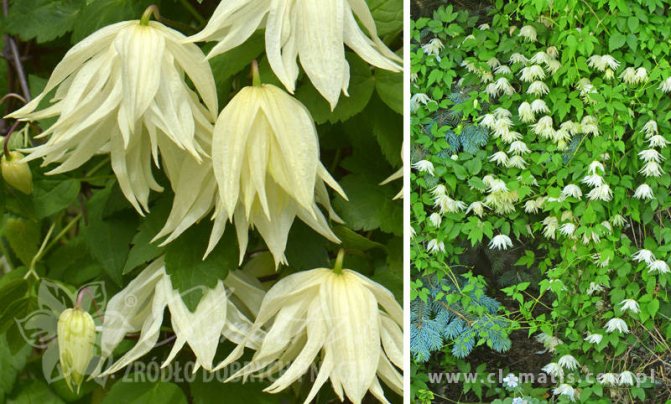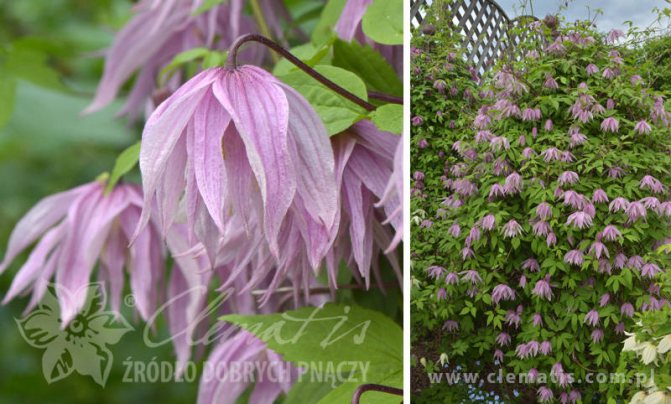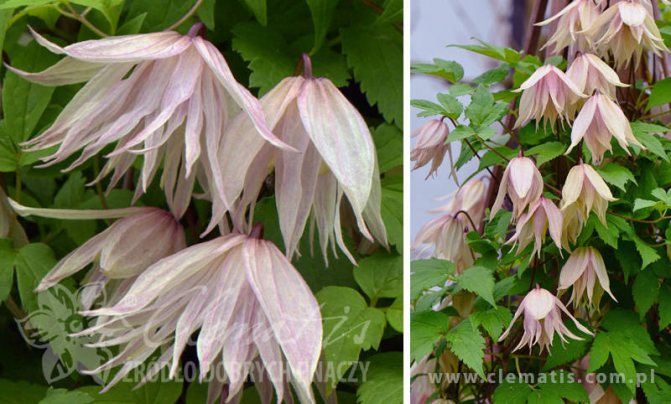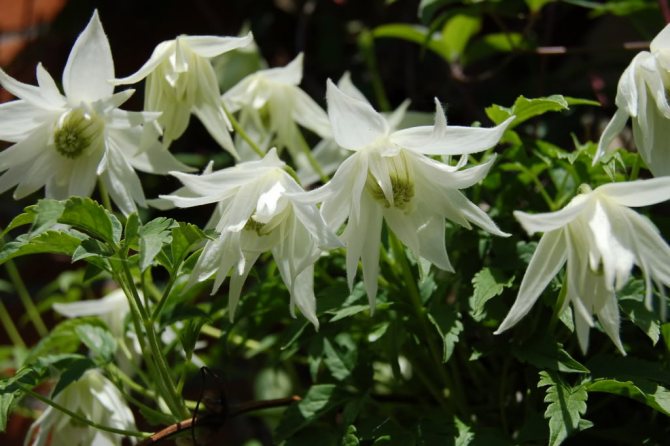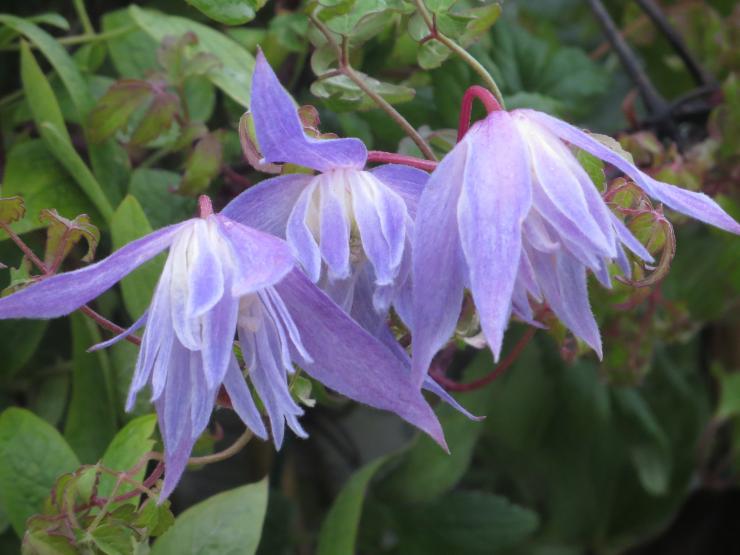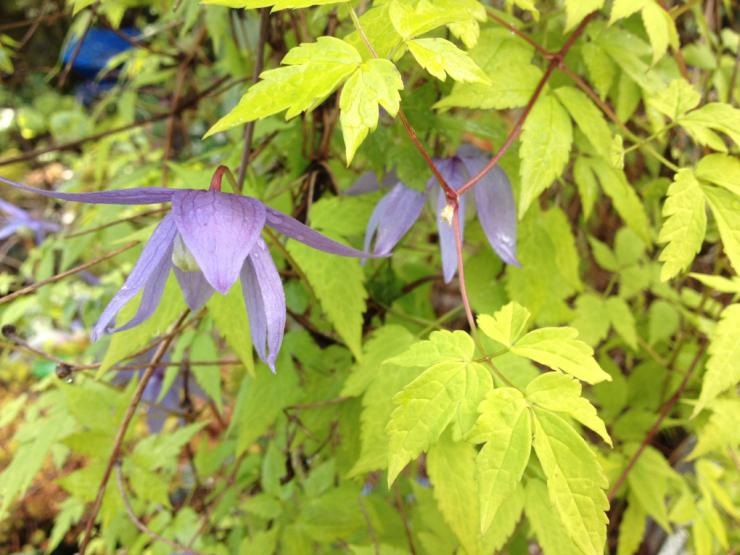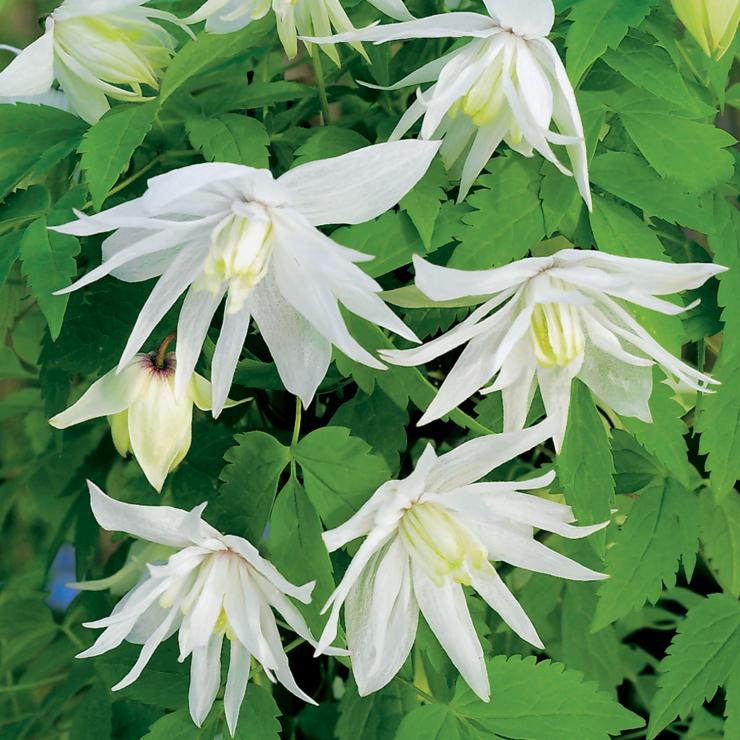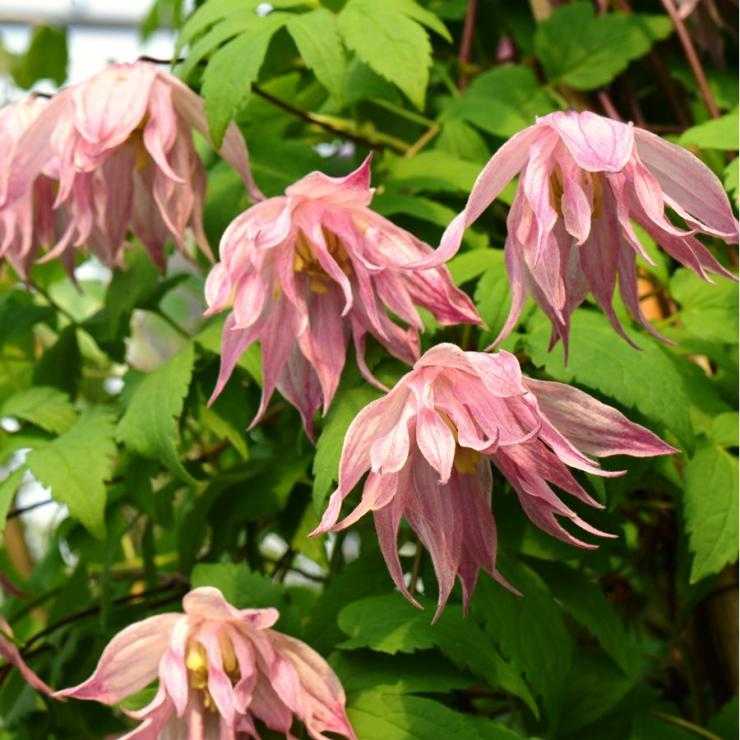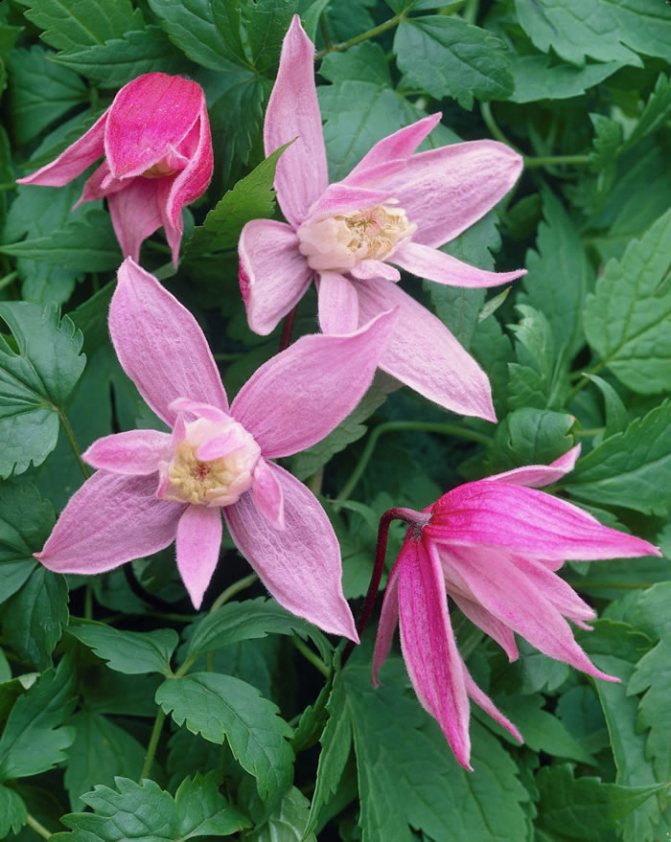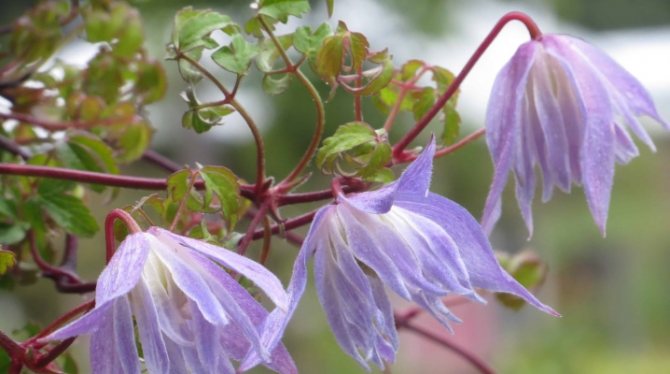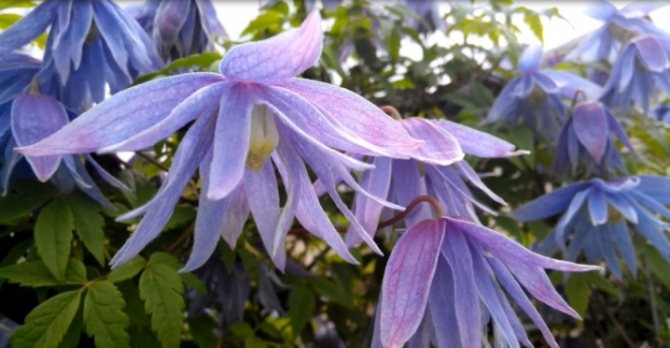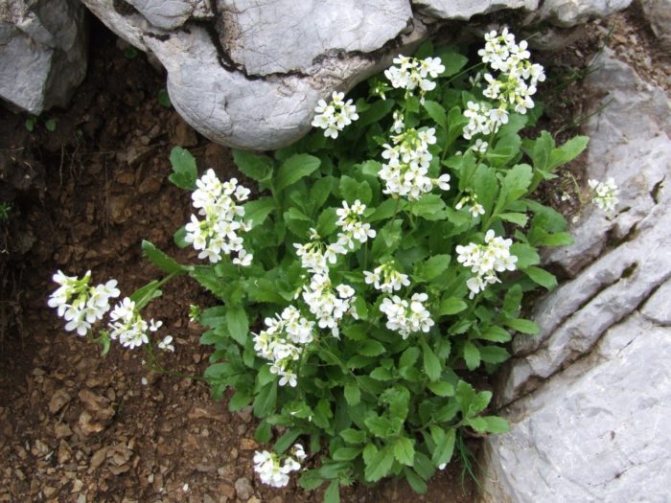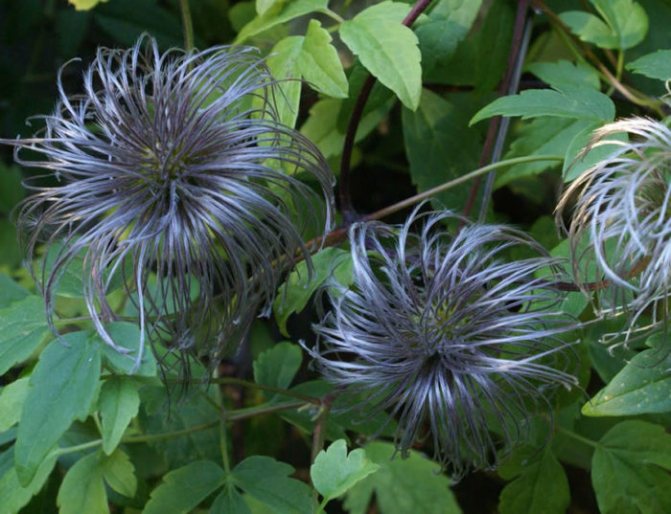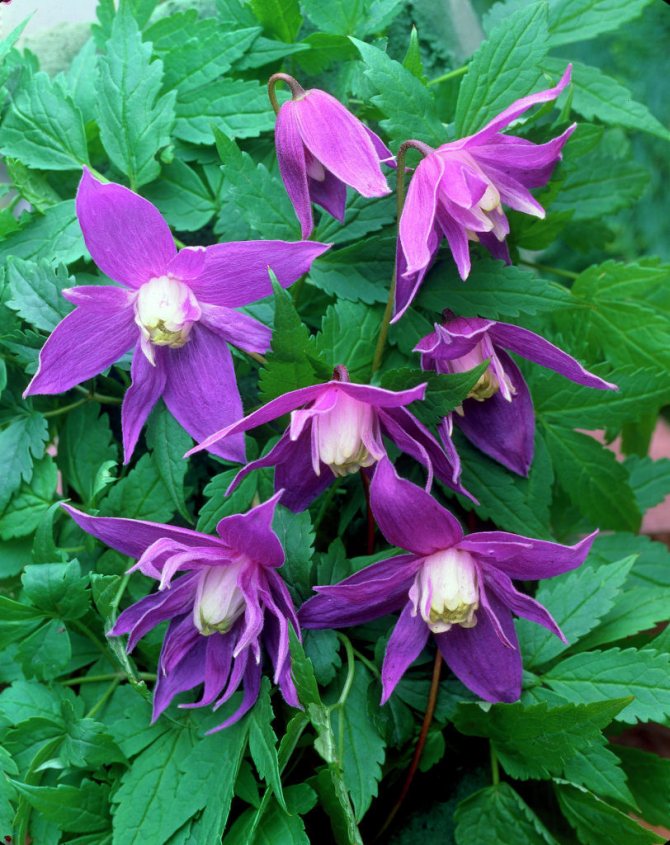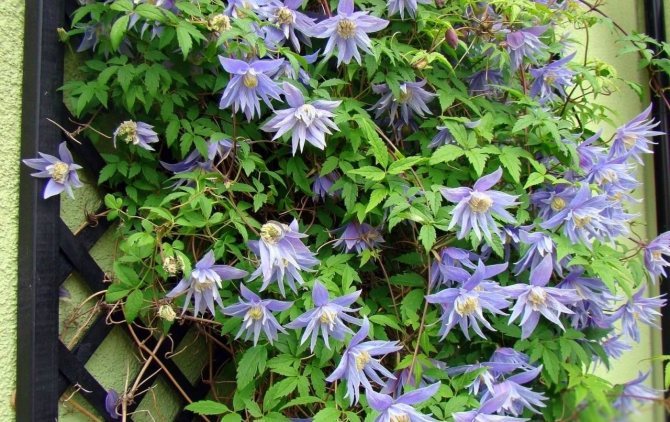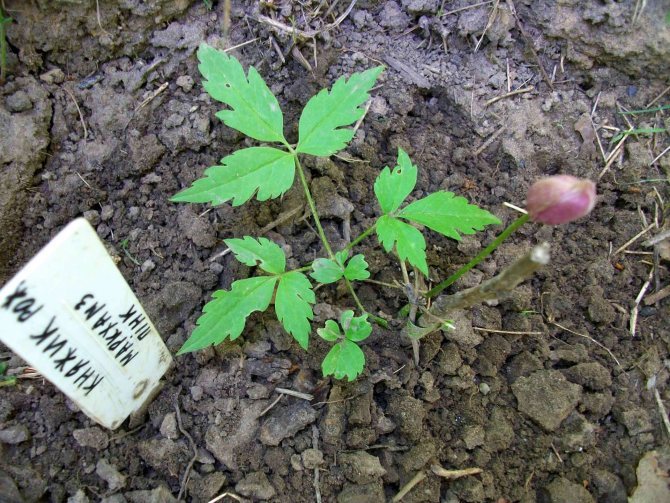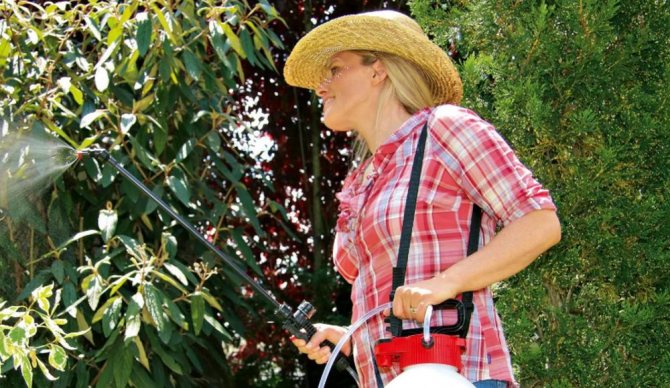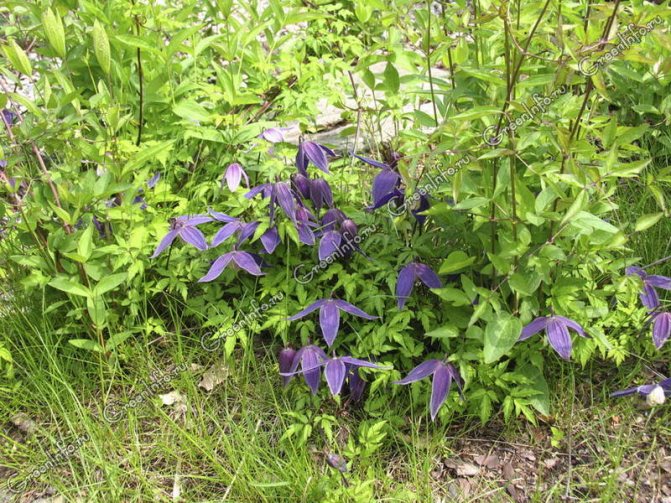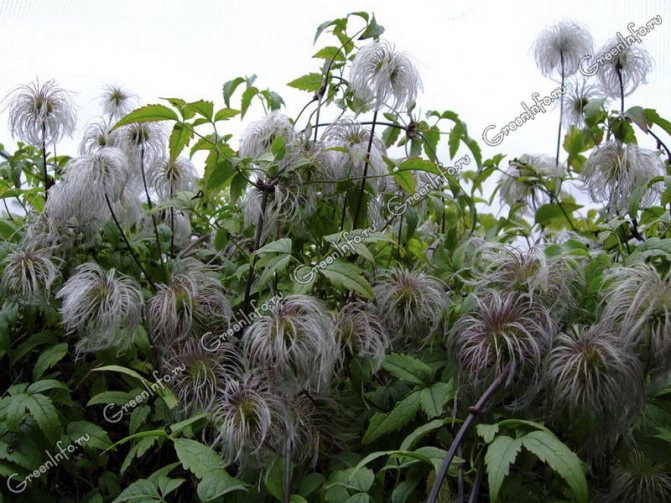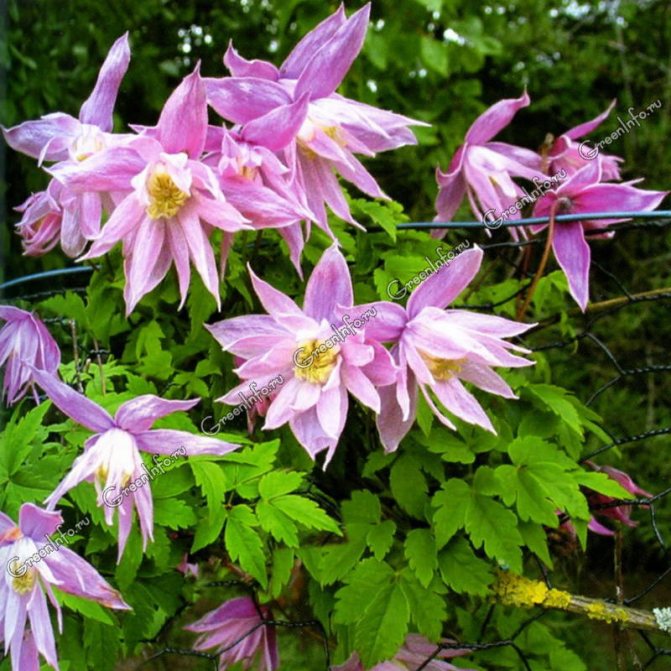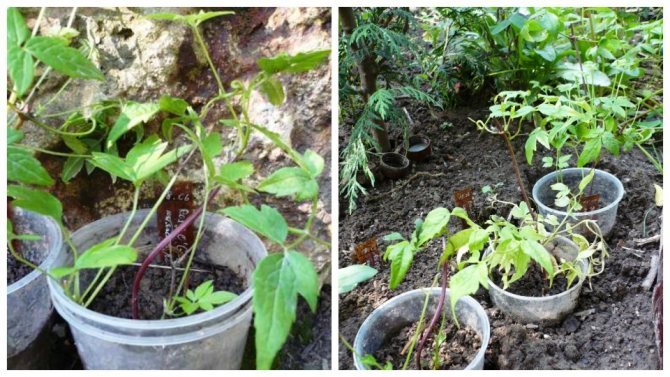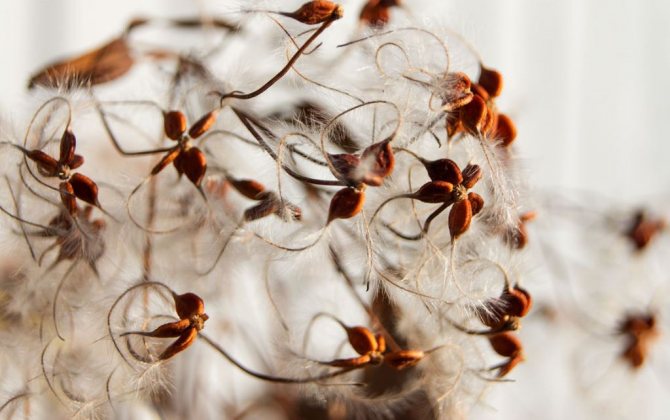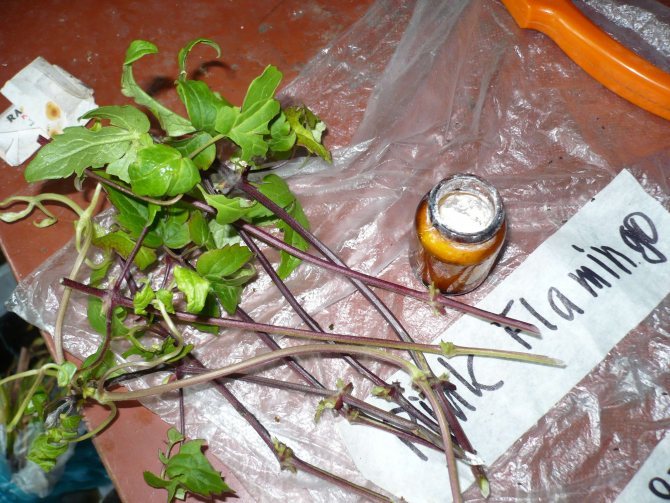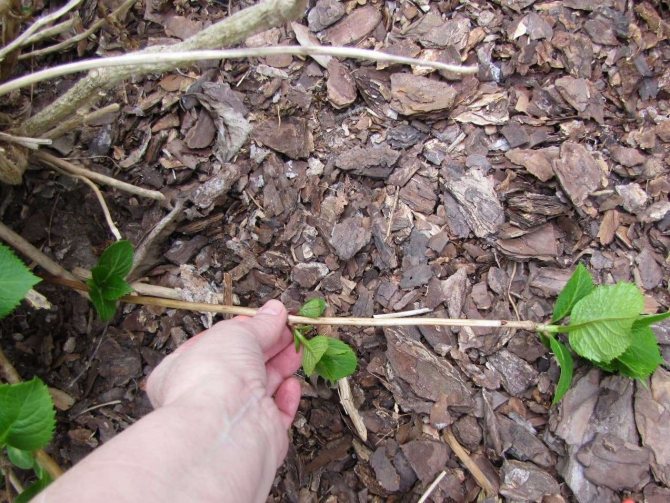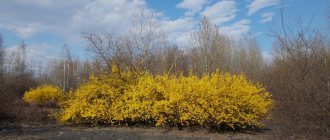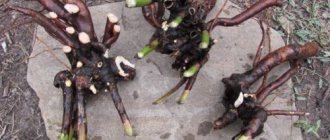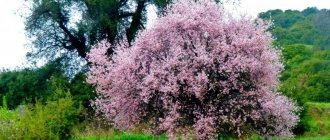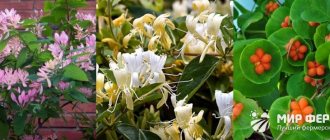Beautiful princes
Dukes and clematis belong to the buttercup family. They are so similar that some botanists classify them as one genus - Clematis. The difference between plants is only in the fact that the flowers of the prince have small and almost invisible petals, bordered from below by large brightly colored calyx leaves. Clematis has no petals at all, but only a differently colored cup of 4-8 leaves in different species, which we take for the flower itself. Alpine prince - Atragene alpina L. Grows in Central Europe along the banks and rocky cliffs of rivers, in shrub thickets. Liana, rising to a height of 3 meters, attaching itself with long twisting petioles to the support and hanging from it with thick garlands.
The flowers are broadly bell-shaped in shape, 2-6 cm in diameter, azure-blue or bluish-purple in color. The prince blooms in May-June. Numerous, collected in a head, fluffy fruits ripen in August-September. Has varieties (forms) with pink and white flowers.
Varieties with flowers of various colors:
- ‘Pink Flamingo’ (‘Pink Flamingo’) - liana 2-3 meters high, pink flowers, drooping 6-7 cm long. Abundant flowering in April-June, repeated single flowers in July-August. First trimming group.
- ‘Pamela Jackman’ (‘Pamela Jackman’) is a 2-3 m high liana, blue-violet flowers, drooping, 4-5 cm long. Flowering on last year's shoots in May. First trimming group.
- ‘Willy’ (‘Willy’) -liana 2-3 m high, flowers from white to deep pink, drooping, 5 cm long. Abundant flowering in May. First trimming group.
- ‘Francis Rivis’ (‘Francis Rivis’) - liana 2-3 m high, blue flowers, drooping with long (5-8 cm) petals. Blooms profusely in May-June. First trimming group.
Recommended for vertical gardening of low objects, fences and tree trunks, planting among stones (for rock gardens). They deserve wide distribution in the more northern regions of the Russian Federation. In culture since 1792.
Grand Duchess - Atragene macropetala. Homeland - Eastern Siberia, the Far East, China, Korea, where it is found on the forest edges of coniferous and deciduous forests. Very rare in culture. It grows even on the Kola Peninsula in the Polar-Alpine Botanical Garden, but its culture is more reliable south of St. Petersburg.
The virtues of the flowers of the princes
According to the description, the flowers of the princes are not as diverse in shape as the flowers of clematis - they are mostly bell-shaped, they are simple and double, of different colors.
But because of the characteristic drooping shape of flowers hanging on long pedicels, many find princes more graceful than clematis. The princes bloom earlier than clematis - in May-June and only on the shoots of the last year, so the shoots are not cut off after flowering.
A great advantage of the princes is their high frost resistance, they confidently winter in the Moscow region, withstanding frosts down to minus 35-40 ° C without being removed from the supports. In addition, they are extremely resistant to a lack of illumination and can grow and bloom for many years in conditions of only reflected light without loss of decorativeness.
Sometimes in warm summer princes can bloom again in August-September. Refers to the first trimming group.The princes do not prune, more precisely, they occasionally carry out anti-aging pruning. After four to five years, heavily overgrown bushes will inevitably become bare from below, which in many cases reduces their decorative effect.
Therefore, it is believed that once every few years they must be completely cut to the ground in order to stimulate the regrowth of young shoots. This should be done immediately after flowering (in June), so that new shoots can grow during the summer, which will bloom as early as next spring.
Sometimes, in order not to weaken the bushes, especially the old ones, proceed as follows. If strongly lignified shoots can still be divided, some of them, after flowering, are carefully cut to the base, and the second part is left to grow.
Due to their high frost resistance (minus 40-45 ° C), princes are especially interesting for cultivation in regions with rather severe winters. Therefore, at present, many different varieties have been bred with flowers of various shapes and sizes - simple and double, drooping bell-shaped and open with soaring sepals, with a diameter of 3-4 cm to 7-9 cm.
Varietal variety
As mentioned earlier, on the territory of Russia, princes are represented by 4 types:
- Alpine;
- Okhotsk;
- Siberian;
- large-petaled.
The homeland of the alpine species is Southern Europe. In the presence of high supports, it reaches 3 m in height. Buds are formed on overwintered shoots. The flowers are drooping, from 2 to 6 cm in length, formed from May to June, and have a delicate purple color. By the end of the growing season, young branches lose their flexibility and become covered with tree bark. In regions with a prolonged summer period, clematis blooms again at the end of the growing season (from August to September). To rejuvenate it, flower growers cut the lashes up to 2-3 knots from the root every 3-4 years.
The prince of the Violet Purple variety has purple-crimson flowers with a yellow center, their diameter is 5-6 cm. It is appreciated for its compact and neat appearance, the ability to grow in containers.
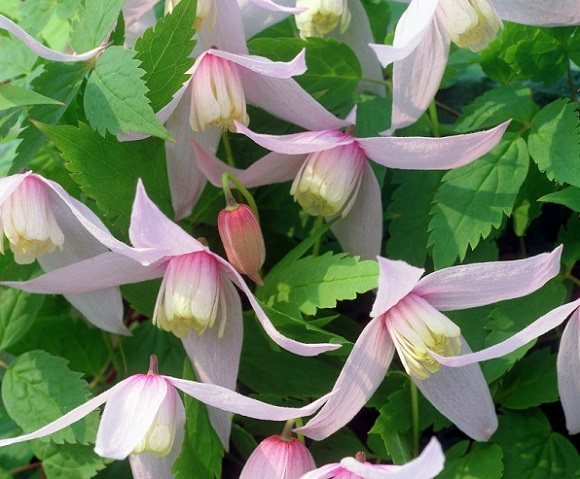
Willy's variety
For planting in the garden, beginners prefer to choose varieties:
- Willie;
- Cyanea with a velvety coating on the veins;
- Frankie;
- Light pink Pink Flamingo;
- Ruby with elegant foliage;
- semi-double Constance and others.
The Okhotsk species is considered the most frost-resistant. The varieties have elongated (up to 2-3 m) herbaceous stems, the area of distribution is the Primorsky Territory. The flowering period depends on the region of planting, it varies from May to the end of June. Vine buds drooping, flowers resemble bells, consisting of 4-8 sepals. They are formed on overwintered shoots. Petals can be blue, purple, azure color. In preparation for wintering, the stems are not cut off. But weigels have a positive attitude towards pruning, so at this time you should not forget about them.
- Siberian and large-petal species
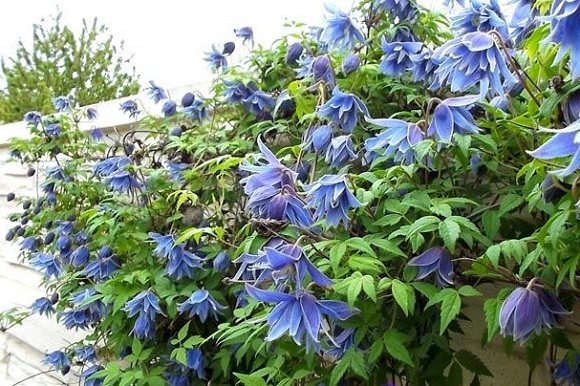

Siberian prince Siberian varieties of clematis are sung in poetry and prose of the past. They are often identified with wild hops and are described as very delicate and sophisticated plants. Distributed from the Urals to the Sayan Mountains, easily recognizable by the white water lilies of flowers and a large number of bees around them. They have a delicate sweetish aroma, thanks to which they are recognized as the best decorative lianas for garden and park areas and summer cottages. They are characterized by high winter hardiness and can lie under the snow without damage to the vegetative system for more than 5 months.
In the shaded area, the flowering period is delayed for several weeks.
The large-petaled prince comes from the Pan-Asian countries (China and Japan). From there it was brought to the Far East, then the growing area spread to Western Siberia. This species is photophilous, resistant to direct sunlight. Differs in spectacular large purple flowers. The drooping buds have a double shape, reaching 4-5 cm in diameter. The flowering period lasts from May to June.It is considered the most whimsical representative; temperatures below -25 ° C are harmful for him. When preparing the garden for the winter season, the liana is stopped up to 2-3 knots from the root, the fresh cut is treated with garden pitch, and the plant itself is placed in a hole and covered with mulch.
Of the varieties, it is worth advising:
- powerful Anders with abundant flowering;
- Ballet Skirt with a warm pink shade of petals;
- Ash Spider, suitable for growing in containers;
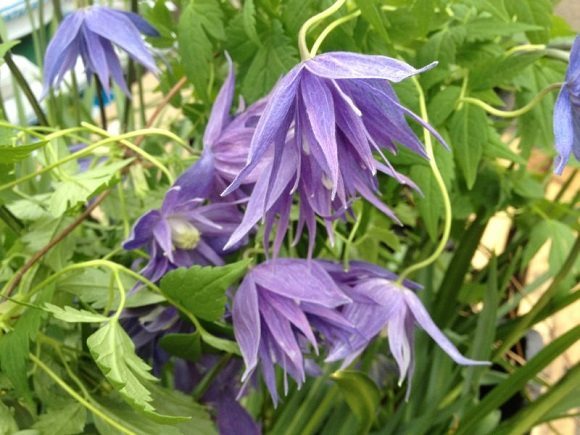

Lagoon variety - blue lagoon;
- Terry White Swan.
There are no problems with planting the prince and further leaving, the set of actions will be the same in relation to any of the above types.
Best views
On the plots 4 types of princes are cultivated, which grow in our climatic zone.
Siberian, or beautiful prince, in nature grows on the slopes, forests and rocks of the Pamirs, Tien Shan, in the Urals, Siberia and Karelia. Liana reaches a length of three meters. The flowers do not exceed 4 cm in diameter. They are usually yellow or white, with a delicate aroma. They are distinguished by an unpretentious appearance, such princes grow both in sunny areas and in the shade. It blooms in May; under favorable weather conditions it blooms again in autumn.
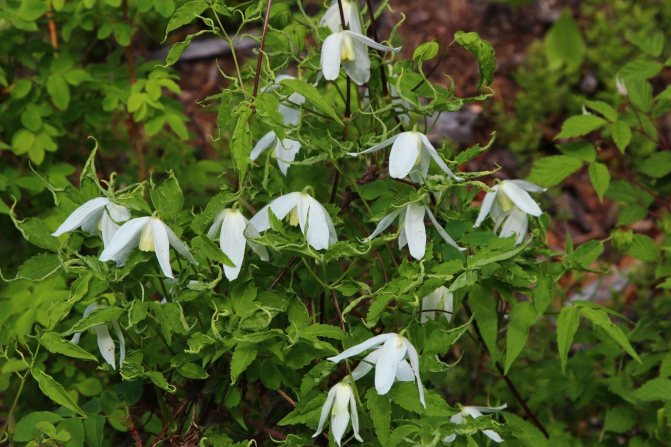

Siberian prince
Okhotsk view found in the Far East, Eastern Siberia, Korea, China, Japan. In early June, large blue or purple flowers bloom on the plants. This is the most frost-hardy prince. He prefers semi-shady places with moist soils. The purple-violet Tage Lundell variety is often on sale.
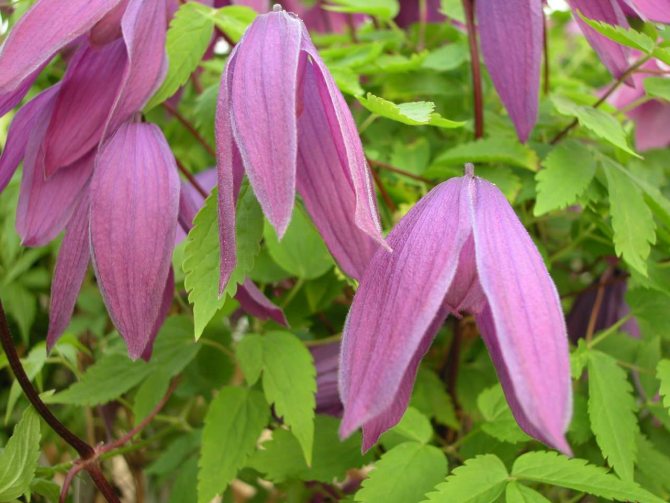

Prince of Okhotsk
In the Far East, Korea and China, there is another type of plant - large-scale... It grows only in sunny places, it is afraid of frost, therefore it requires shelter for the winter. Blooms in large blue flowers in early summer. Breeders have worked on this species and bred 28 varieties on its basis.
Most popular:
- with blue flowers - Estrella, Jan Lindmark;
- with blue-violet - Maidwell Holl;
- with pink - Markham's Pink, Rosy O'Grady.
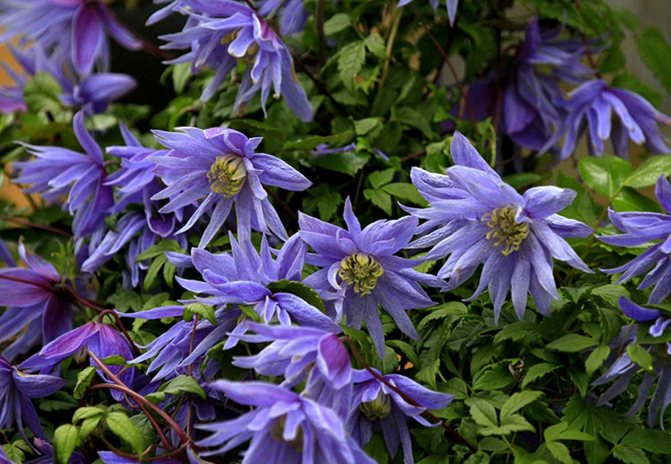

Prince Maidwell Holl
Alpine view - This is a fast-growing curly representative of the princes, the length of its stem does not exceed two meters. In nature, it grows in the temperate zone of Eurasia. Blooms in May-June, buds appear on last year's shoots. This must be remembered when pruning, so that later you will not be surprised why the plant does not bloom. Sometimes it pleases with repeated flowering in the fall. Prefers to grow in partial shade on moist soils. This species was one of the first to come into the field of vision of breeders, on its basis varieties with different flower colors were bred:
- White Columbine - with white flowers;
- Pink Flamingo - with pinks;
- Pamela Jackman - white and pink
- Francis Rivis - with blue flowers.
The variety "pink flamingo" is worth paying attention to, as it is an early flowering vine. The first flowers appear at the end of April, it blooms again in August.
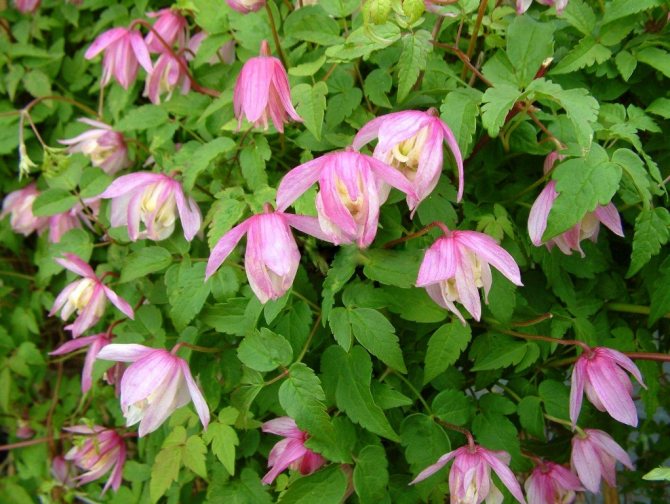

Prince Pink Flamingo
Princes: types, varieties, planting and care features
Luxurious princes are incredibly beautiful flowers, they are used to create arches in personal plots. In order to grow vines, you need to familiarize yourself with its varieties. This will make it much easier to choose the right variety for your yard.
If we consider this plant in more detail, then first of all it is worth saying that princes are considered quite close relatives of such a plant as clematis. They are referred to the Atragene group. They differ from their congeners quite a bit. The first thing that catches your eye is the longer vines, the size of which reaches 4.5 meters.
The princes bloom very early, in early May. However, there are earlier varieties that bloom from April to May. They can be used to decorate areas located in cities with a warm climatic zone.
The advantages of princes over other types of clematis
Boron hops are common in the wild. You can meet him at the edges of forests among thickets of bushes. Clinging with shoots to the trunks and branches of trees, the liana completely entangles them.In some mountainous regions of the Alps, whip-like atragenes fall from slopes and ledges, forming beautiful flowering curtains.
Adapted to the conditions of the wild, they are particularly unpretentious when grown in gardens and parks. Varieties of panicle hydrangea are more finicky in this regard. Among the main advantages it is worth noting:
- high winter hardiness of certain varieties;
- arbitrary wintering, in which the plant does not require seasonal pruning;
- resistance to frequent transplants;
- fast regeneration of the root system;
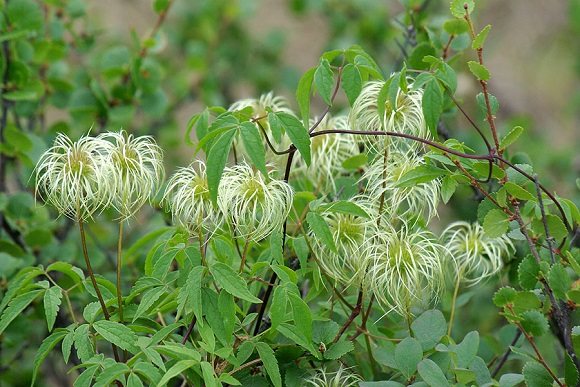

Lianas after flowering - bloom earlier than their counterparts (most varieties from mid-May);
- active growth rates, allowing for the season to create an extensive green curtain from prying eyes;
- abundant flowering even on depleted soils;
- resistance to sudden temperature changes;
- the presence of a glycoside in the fibers of the plant - a poisonous burning substance that can protect against the invasion of parasitic insects and fungal diseases;
- high nectar content in flowers.
Padalka (seeds) is distinguished by friendly germination. In species clematis, planting material must be stratified and grown at home to seedlings.
Let's summarize
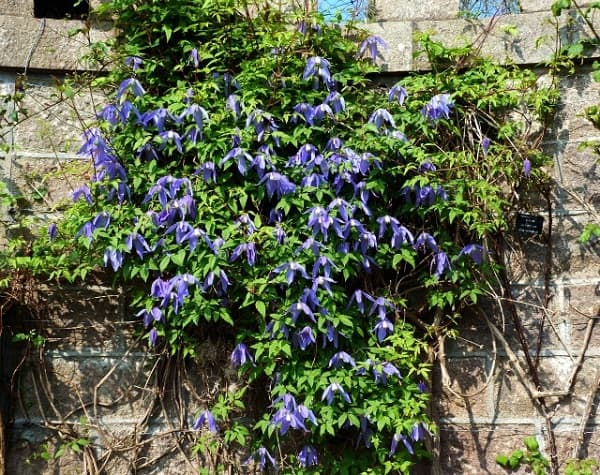

- The princes are a relative of clematis. Plants differ only in the structure of the flower.
- There are four decorative types of princes. The most popular varieties sold in most stores are Francis Reeves, Stolvik Gold, Pink Flamingo, Pamela Jackman (alpine species), as well as Maidway Hall, Cecile, Markhvens Pink (large-petal species).
- You can plant the plant in a secluded, shaded corner of the garden.
- When growing clematis, remember: they love moisture, so they need to be watered from time to time, and between waterings, a layer of mulch should be renewed on the site.
This is interesting: Propagation of roses by cuttings at home
Overview of species and varieties
There are a large number of princes, and first you need to familiarize yourself with the most common types.
It is worth considering the popular species that have given birth to many bred varieties.
- Alpine... These plants are native to European countries. Mostly it grows in mountainous areas. Vines can grow up to 3.5 meters. The flowers are quite bright, purple in color. The flower itself has an elongated shape, reaching up to 8 centimeters in size. Flowering can occur 2 times a year. The first time in early June, and the second in early September. It is worth noting that the second bloom is no longer so abundant. In order to rejuvenate the bush, experts recommend using periodic pruning.
- Okhotsk. It belongs to the most frost-resistant species. In its natural environment, it can be seen in the Primorsky Territory. The height does not differ from the previous species, but the shade of flowers, as a rule, is blue. In addition, they are more lush and full-bodied. Flowering begins in early June.
- Siberian... This type of princes is most often found in Siberia. It can grow both on the sunny side and in the shade. The flowering of the Siberian prince begins in the first weeks of July. The green carpet is decorated with single inflorescences, with a white or yellow color, the length of which is at least 5 centimeters. They have a very pleasant smell, which attracts a large number of bees and insects.
- Large-sized. Like the previous type of flowers, the plant grows in Siberia. They differ from other plants in their unusual structure. The outer sepals are larger than those inside. This makes them look more voluminous. Flowering begins in mid-summer. For the winter period, all vines must be removed from the supports and covered with spruce branches.
- Korean. For the first time, flowers were bred in Korea. They are long creeping vines with red-yellow buds. In rare cases, the color may be purple. However, such specimens are rarely grown in gardens.
Next, you need to consider the most popular varieties that are grown in gardens, and in parks, and in personal plots. The most common are "Albina captivity", "Octopus" and many others.
- Cecile... Refers to frost-hardy and large-flowered types of princes. Flowering begins in early summer. The buds are blue-lilac in color.
- "Pink Flamingo"... Liana grows up to two meters. There are pink flowers on it, the length of which reaches 9 centimeters. It blooms twice. The first bloom begins in late April or early May, the second in late summer.
- "Ballet Skirt"... This variety is distinguished by very delicate flowers with a pink tint. Most often used to create arches.
- "Midewell Hall"... The vines of this plant grow up to three meters in length. On them are flowers of a rich purple hue, the length of which is no more than 5 centimeters. In their natural environment, they grow along rocky shores.
- Francis Rivis... It is a liana up to two meters, with blue flowers, the length of which reaches 9 centimeters. Flowering begins in early May.
- "Stolvik Gold"... This sort of princes is especially beautiful and unusual. It is impossible to take your eyes off its blue buds with very lush centers. The flower can grow up to 6 centimeters in diameter. In addition, golden leaves grow on vines. Flowering can occur twice a year. For the first time - in the spring, and the second time - at the end of summer.
- "Purple Dream"... This variety was bred by the Polish breeder Marchiński. Its vines grow up to three meters. On them you can see beautiful double flowers, the diameter of which reaches 11 centimeters. Their colors are most often purple-cream. Such a plant is resistant to frost.
- "Lemon Dream"... Another variety of the Polish breeder, which amazes with its magnificent appearance. Terry flowers with a lemon shade are quite large, up to 12 centimeters in diameter. When the flowers are just starting to bloom, they have a greenish tint, and during full blooming they become almost white. The flowering of this plant occurs 2 times for the entire time. The first time is in early May, and the second is in the middle of summer. Like the previous type of princes, this variety is not afraid of frost.
- "White Swan"... This plant got its name due to the fact that it has white buds. Flowering most often occurs from the beginning of May and lasts until the end of June. In some cases, flowering can last an entire summer.
Growing and care
Caring for princes in the open field is quite simple. Some features for choosing a landing site for princes:
- their flowering in a sunny place begins earlier, but lasts less;
- in partial shade, on the contrary, the flowers bloom later, but the flowering period itself increases;
- in the shade, the flowering is less abundant and lush, but it lasts even longer.
The princes are quite unpretentious and do not require much care from gardeners, unlike clematis. In the open field, they easily take root in sunny areas and slightly shaded areas. Their flowers have a delicate, vulnerable structure, like that of clematis, so it is recommended to protect the plant from strong winds.
Beside them below, you can plant plants with a small root system to shade the lower zone. Planting flowers is possible in any soil, except for overly wet and swampy areas. Loose fertile or slightly alkaline is well suited.
Water them in moderation, with the exception of the first year of life. At this time, in dry sunny weather, they need a lot of moisture. Their long roots, going deep underground, are able to extract moisture on their own.
It is advisable to carry out regular fertilizing of flowers, especially at the beginning of growth in spring and before budding. This contributes to a more abundant and lush flowering, the leaves are filled with color and become more glossy. Although the princes can do without fertilizers for a very long time.
To rejuvenate the bush, you need to carry out periodic pruning every 5 years.After the plant has bloomed, the shoots are shortened to 70 centimeters. Do not forget to get rid of old dried leaves and stems of the vine and carry out periodic maintenance.
Which variety should you choose?
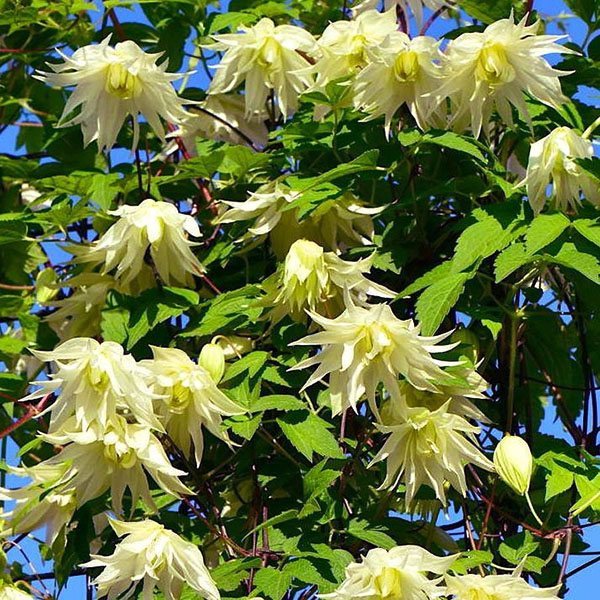

If we consider the princes in more detail, the varieties of this plant are very similar in appearance, but have some distinctive features. The cultivar Ballet Skert also stands out with its pale pink flowers. It can be used to form living curtains of arches or trellises in the garden. The prince Lemon Dream of a gentle lemon shade also looks great. Its sepals are slightly elongated with wavy edges. The flowering of the plant occurs in May, and in the summer this phenomenon is repeated, but not so abundantly. The plant can be used as a ground cover crop.
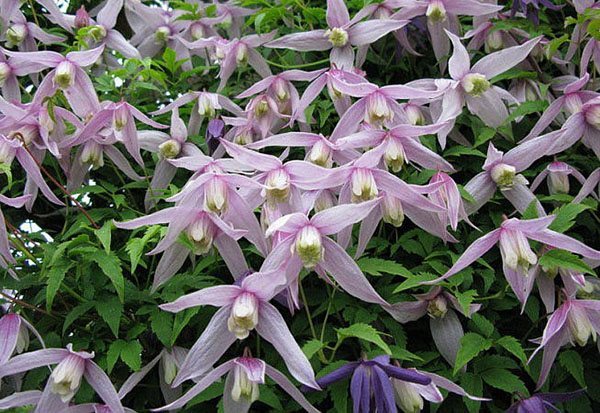

Gardeners and the Alpine prince with beautiful flowers of a pink or purple hue do not bypass the side. His homeland is considered to be Central and Southern Europe. Flowering usually begins between May and June. If favorable conditions are created, then the plant, as in the case of other varieties, will bloom again in the summer. It is better to choose moist soil. The best location is in partial shade.
Varieties of varieties
There are several of the most popular types of clematis Knyazhik:
| View | Description |
| Alpine | The natural habitat is the forests of Europe and the Baltic states. The flowers are in the form of large bells, on them there are 4 sepals, in which the petals are hidden. Among the shades that characterize this variety, stand out: pink, lilac, blue and purple. The rich green leaf plate has a triple shape and serrated edges. The flowering period begins at the end of May. Popular varieties of this type of Knyazhik:
|
| Large-lobed | The homeland of this species is the Far East, as well as Korea, China and Siberia. A feature of the large-petaled Knyazhik is the terry structure of the inflorescence, which gives it splendor and elegance. There are more small petals covered with upper sepals in this species than in others. It is also more demanding in the care and especially in the shelter of the bush in the winter. The following varieties of this type are widespread:
|
| Siberian | In natural conditions, it is found in the coniferous forests of Russia. The bush can grow up to 3 meters. The species is distinguished by abundant flowering. Flowers are white or yellowish in color, resemble bells in shape. The flowering period falls in the middle of the summer season. Often pleases gardeners with repeated flowering in early autumn. This Knyazhik is distinguished by frost resistance and a delicate, sweet aroma emanating from flowers. |
| Korean | The least popular species, rarely found in Russia. It features bright yellow, red or purple flowers. The height is from 2 to 3 meters. |
Landing features
You can grow princes in various regions of the country. But anyway there are some rules to follow... For example, the area where they will be planted must be in partial shade.
For people in the south, it is best to grow these plants from the north side.... In addition, it is best if they are protected by either buildings or trees. In the case of landing princes under the sun, not only flowers, but also leaves will become smaller.
In addition, it is necessary that there are no drafts and strong winds at the place of their landing. Soils should be breathable and absorb moisture quickly. If the soil is too acidic, then it must be mixed with slaked lime. You need to add 100 grams per bush.
A hole must be dug in advance, 10-14 days before planting... At its bottom, you need to lay out broken slate, which will serve as a drainage layer. In addition, fertilizers can be added. So, one bush will require up to 5 kilograms of either humus or compost.And you can also use wood ash, it will be enough 0.5 liters, or buy superphosphate in the store.
After that, the prince's seedling must be cut off by making an incision slightly above 2 buds. Then it can be installed in the middle of the pit. The root collar should be at least 10 centimeters from the top. After that, it is imperative to water the prince.
If more than one bush is planted, then the interval between them should be at least one meter. This can be done both in spring and autumn.
Planting and growing
Gardeners recommend planting atrogens in loose black soil or slightly alkaline soil. Like most clematis, they do not tolerate acidic and saline soils. A place for a bush is chosen on the sunny or slightly shaded side of the site. A series of photos taken in the garden will help determine the position of the sun over the site at different times of the day. The best place is a hill where stagnant water will not accumulate.
Planting instructions:
- Princes are planted in open ground in the spring before the beginning of the active phase of the growing season. The size of the planting hole should be 2-3 times larger than the root system.
- If there is groundwater at the bottom of the planting pit, drainage from gravel or sand is provided. The layer should be 20-25 cm. A bucket of humus, a little peat and sod land are poured on top for fertility, 1 glass of wood ash is added. If the land on the site is acidic, add 150 g of slaked lime.
- The seedling is placed in the center of the planting pit, the roots are spread and covered with earth. The root collar is deepened by 4-5 cm, in cold regions - by 10-12 cm.
- After planting, the soil is compacted and watered.
Video about the features of cultivation.
In one place, they can grow for about 20 years, dispensing with frequent watering and pruning, but this does not mean that systematic care can be excluded. It is necessary to irrigate and loosen the ground under the bush as it dries. To retain moisture, soil mulching is used, planting of low-growing crops with a dense, creeping crown.
- Top dressing during the season
Top dressing of rooted bushes is carried out three times per season by the root method. For this, mineral and organic fertilizers are used alternately. Complex fertilizers containing humates are ideal for them. From organic matter, rotted compost is actively used, it is poured into the trunk circle.
Pruning princes, rooting cuttings and cuttings
In the spring, crown-forming and sanitary pruning is carried out. All dry, deformed and lateral shoots are cut from the bush. After this procedure, the root system is actively growing. Once every 3 years, they practice rejuvenating pruning, cutting off old lashes at the root.
It is advisable to cut it after flowering, so that young shoots have time to grow before the end of the season, and the next year they form buds.
If you want to get a new seedling, then it will be advisable to root the cuttings. To do this, several shoots resort to the land, cleared of weeds, secure with hairpins, sprinkle with fertile soil. So that roots begin to grow in the axils of the leaves, the soil around is periodically watered. After a year, young seedlings can be safely separated from the mother's vine.
In addition to cuttings for propagation, flower growers actively use cuttings with one pair of opposite leaves. Cut green and already lignified cuttings for rooting. The main condition for survival is soil and air moisture, i.e. growing in a greenhouse (under a hood). The first roots appear after 3 weeks. The seedling is grown at home or in greenhouses. It should be planted in open ground no earlier than in a year.
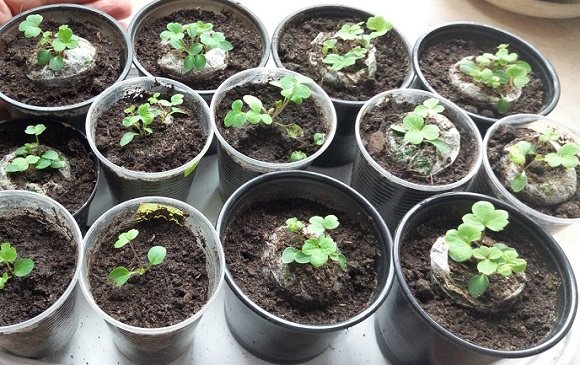

Shoots of clematis
Experimenters and experienced summer residents do not ignore the method of growing clematis from seeds. It is more troublesome, but allows you to get a lot of seedlings of different varieties.
Landing in open ground
In the middle lane, the prince is planted in the spring - in May or in the fall - in early September.
For planting, they dig spacious holes 60 cm wide and deep. Drainage 10-15 cm thick is placed at the bottom of the hole and partially filled with loose and fertile soil. Cuttings or seedlings are placed on an earthen mound in the center of the pit, the roots are straightened and covered with moist earth. The root collar should be 5–8 cm deep for young specimens, 10–12 cm for mature plants.
A layer of clean river sand mixed with wood ash is poured around the root collar, and the rest of the earth is poured on top. So water will not accumulate at the base of the bush during watering. After planting, the soil around the plant is compacted and watered. The distance between tall vines should be at least 1.5 m, for short princes - 0.7-1 m.
Watering
Plants are watered abundantly once every 7-10 days. In the heat - 2-3 times a week. 2-3 days after watering, the soil around the bushes is loosened.
Top dressing
Vines are fed at least 4 times a year. In early spring, nitrogen fertilizers are used, during the budding period and after flowering, organic and mineral fertilizing is combined. In September, autumn fertilizers are applied with increased doses of potassium.
Prop and trim
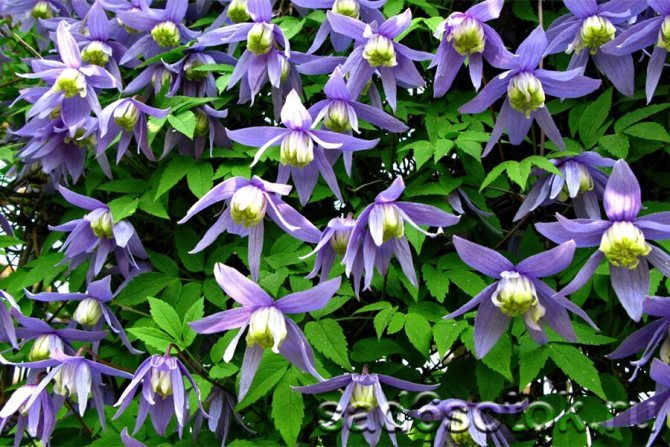

Support is needed to grow a prince
Light but strong supports are installed for plants. After planting, the shoots are immediately attached to the support. The garter will set the right direction for growth. The bush will look beautiful, be less damaged and suffer from fungal diseases.
The princes do not prune in the fall - they bloom profusely only on the shoots of the previous year. Only weak shoots in thickened bushes are cut off. In the spring, to maintain a decorative appearance, part of the shoots that previously had flowers are removed.
Reproduction methods
Dukes can be propagated in several ways:
- Seeds... They are harvested after the end of the flowering period.
- Cuttings... For this, young shoots are used, which already have 5 - 6 leaves. They are placed in a container of water until a root system is formed. A stalk with a strong root can already be planted in the ground.
- Layers... This method is used in early spring. This is the most common breeding method for Princes. A groove is made in the ground 4 to 8 cm deep. A strong branch of the bush is placed in this groove. In the locations of the outlet with leaves, the branch is covered with soil. Caring for such a branch is exactly the same as for an adult bush. After the roots are formed on the bend, each bend is separated from the main plant with a sharp tool and planted as a separate cut.
- By dividing the bush... It is important to remember that this breeding method should be carried out before the start of the growing process. For this, the bush is cut to a height of 30 - 40 cm and completely dug out of the ground. After that, the bush is neatly divided into several parts. Each of them must have a strong root part. This is the key to good and fast growth of new plants.
Each of the types of reproduction has its own characteristics. They must be taken into account when choosing one or another method of breeding Knyazhikov.
Care rules
You can grow plants in the garden, and on balconies or loggias. For those who do it outdoors, for example, in the Moscow region, watering should be done several times a week. This also applies to the autumn period.
Fertilizers must be applied once every 14 days. And you can do this from the time when shoots appear. You can use both organic and mineral fertilizers. In addition, after planting the plant, it is necessary to put a layer of mulch on top, for example, bark or spruce branches. This will help the moisture not evaporate so quickly, which means the bush will not suffer from drought.
This plant belongs to the first pruning group. Flowering occurs on vines left over from last year. That is, the princes do not prune either in the fall or in the spring. Only broken or dried branches are cut from them.
Knyazhiki - the difficulty of growing.
Any soil is suitable for growing princes, the main thing is that there is no stagnation of water. An excellent solution, which will provide the princes with water and prevent its stagnation, will be the introduction of a special hydrogel. Great for princes Evabeona (R) for seedlings and perennial flowers .
How to deposit and how much do you need? A glass of hydrogel is added per liter of soil. It is necessary to proceed from the root volume. For example: you are laying a new hole for the landing of the princes. Its volume is about 12L bucket. So, along with humus and fertilizers, you add about 12 glasses of hydrogel, mixing evenly throughout the volume. The hydrogel will work for about 5 years, providing the princes with water and taking excess moisture into themselves.
In general, remember that if you have large perennial flowers, plants, shrubs and trees on your site, then you need to take exactly the modification with large granules: Evabeona (R) for seedlings and perennial flowers. We recommend packaging 2.5 kg. The gel is stored for 5 years and this amount is enough for all needs.
Rate the article:
[Total Votes: 52 Average: 3.6 / 5]
Diseases and pests
Like any plant in the garden, the Princes can get sick. Among the most common diseases that affect plant bushes, the following can be distinguished:
- Rust... The disease affects the leaves of the bush, on which orange spots are formed. In order to cure the bush, it is abundantly sprayed with Topsin's solution.
- Powdery mildew... The disease manifests itself in the form of a white bloom that covers the whole plant. If you do not start treatment in time, the bush dies. To combat powdery mildew, Topsin's solution or Bordeaux mixture is used.
Among the pests that can harm the Princes, the most dangerous are slugs and nematodes. Slugs must be collected from the bush by hand. As for the control of nematodes, a solution of Carbothion can be used for this.
It is important not to forget that in winter the plant can be attacked by rats or mice. In order to avoid such a situation, the root system can be covered with spruce paws.
Knyazhiki: choosing the place and time of boarding
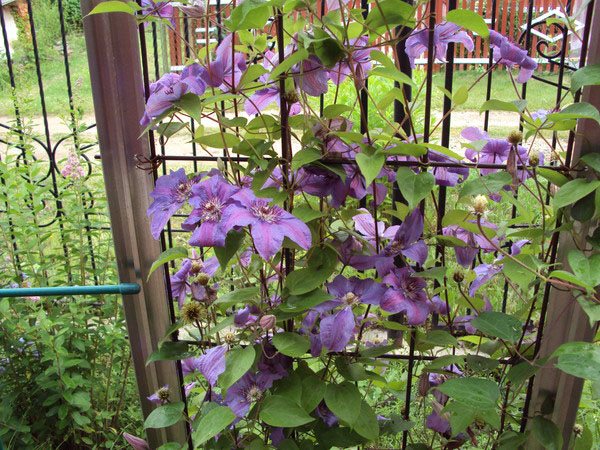

Caring for them is not so difficult, but you need to adhere to certain rules. For planting a plant, it is preferable to choose illuminated areas, but if necessary, the Siberian prince, a photo of which is presented in large numbers, can grow in partial shade, which also distinguishes it favorably from related clematis.
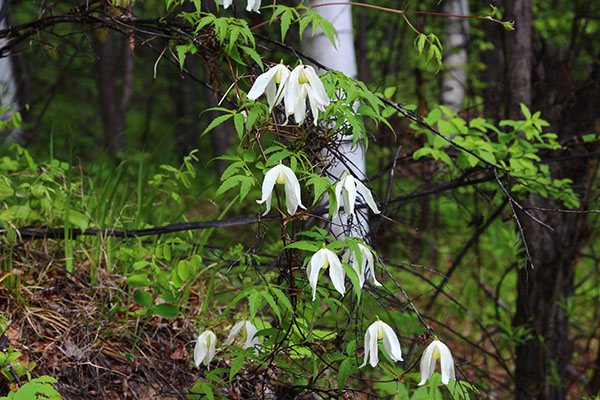

However, drafts should be avoided and care should be taken to protect against cold winds. Since the plant is a liana, support structures will need to be created. It can also be garden fences. During the winter, you can forget about caring for the prince, since this is a rather frost-resistant culture that does not require additional shelter.
The most favorable period for planting a prince in the garden is May.
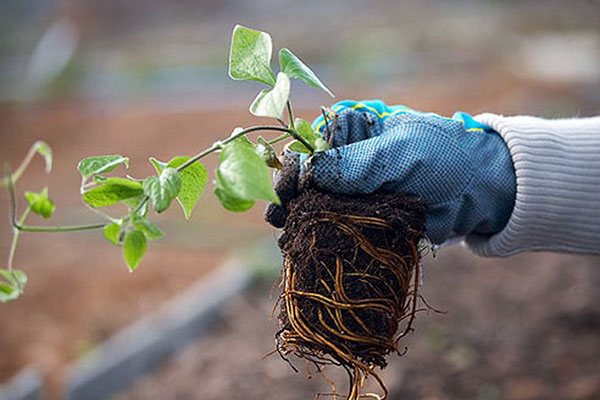

For this, the end of August is also suitable. If you plan to buy princes of a variety for the Moscow region in Moscow, then it is worth considering that two-year-old saplings are the easiest to take root. It can also be cuttings with a root system, but the same age. Before planting, the soil must be enriched with humus or ordinary manure. In order to disinfect it, you can use a solution of potassium permanganate. Liana will grow better if a drainage layer of about 10 cm is created. Soil preparation is carried out well before planting.
Reproduction
This plant can be propagated in different ways.
Using seeds
All seeds must be stratified before sowing. This will significantly reduce the timing of their germination. If ordinary seeds can sprout up to 7 months, then processed seeds - up to two months.
They need to be sown in early April. The mixture should be composed of sand and earth. After disembarking, cover the containers with glass and put them in a warm place. They need to be opened and ventilated daily. In addition, water once a day.
When 4 pairs of leaves appear, the emerged seedlings must be dived into the beds. They can be planted in a permanent place after a year.
The genus has 8 species growing in the Northern Hemisphere. There are 3 species growing in Russia: large-petal, Siberian and Okhotsk. Of the foreign species, the Alpine prince is most often grown in culture.
Knyazhik is a shrub vine with a woody stem, clinging to the support with leaf stalks. Leaves are twice pinnate. Flowers are axillary, solitary, 10 cm in diameter, broadly bell-shaped with petal sepals. Fruits are numerous, fluffy, collected in the head.
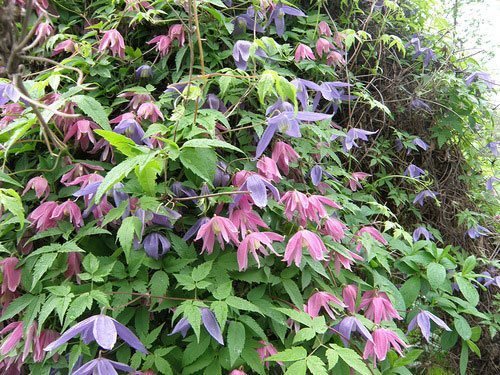

The prince and clematis belongs to the buttercup family. These plants are so similar that some attribute the prince to the genus - clematis. The difference is that the flowers of the prince have almost imperceptible petals, bordered from below by large painted calyx leaves. Clematis has no petals at all, but only a multi-colored calyx of 5-8 leaves.
The prince is more graceful than clematis, even small-flowered. The "soaring" flowers of the prince have not yet been appreciated by our growers. In central Russia, the prince is winter-hardy. By the way, the plant most often goes on sale under the guise of "clematis".
Characteristic
The Siberian prince is an unusually beautiful perennial liana, which is quite adapted to the local climate. Outwardly, the plant looks like clematis, but not so picky and demanding to care for. Belongs to the buttercup family. In nature, the wild Siberian prince grows in coniferous and deciduous forests, it can also be found in the coastal zone or on the edge. It got its name for a reason, because its homeland is Siberia. Very often, the prince is called a shrub vine, the woody shoots of which reach 4 meters. It is characterized by the following features.
- Fragrant flowers, the scent of which fills everything around him. The flower diameter can be up to 10 centimeters. It consists of 4-8 petals, which are ovoid or lanceolate. The inside of the flower is filled with numerous light stamens;
- Unpaired leaves with jagged edges and cuttings. Due to the presence of serrated leaves, the liana has the ability to creep and cling to the necessary supporting structure.
- Wide range of colors. The flower can be purple, pink, white or pale pink in color.
The period of abundant flowering of the liana falls in May-June. From mid-summer to early autumn, the prince also blooms, but not so violently. Seeds begin to ripen by early September. For those who decided to breed this plant at home, we hasten to note the fact that you need to be extremely careful in contact with it - it is poisonous.
It is also very important information that the Siberian prince has excellent medicinal properties. The plant has been famous for its wide use in medical practice for several centuries.
It is often used in the treatment of tumors, tuberculosis, pneumonia, epilepsy, liver diseases, or to restore and normalize metabolism in the body.
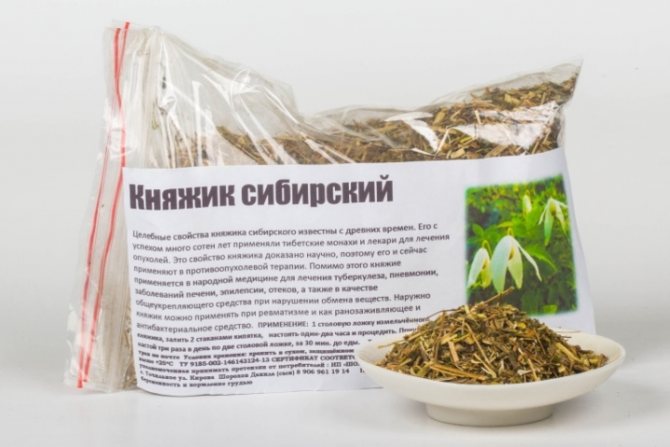

An ornamental and medicinal plant in your garden - prince
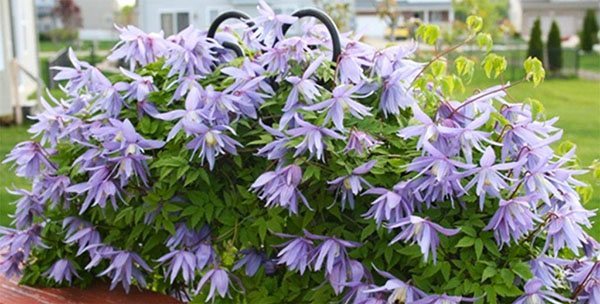

Knyazhik is an incredibly beautiful shrub plant, often used for landscaping personal plots. The plant belongs to the genus Lomonos from the Buttercup family. The first mentions of this vine were found in encyclopedic dictionaries of the late 19th - early 20th centuries. At this time, the plant was known as wild hop or loach. Such names are due to the fact that the plant has woody stems, which cling to the support of the petioles of their leaves as it grows.
Types and varieties of prince
Alpine prince
The Alpine prince grows in the forest and shrubs along the river banks and rocky cliffs of the Central. The plant grows well in the Baltic States and from St. Petersburg to the steppe zone.
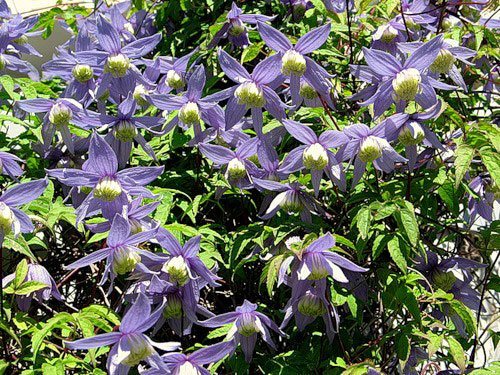

The alpine prince is a liana that rises 2 m in height, attaches to the support with twisting petioles and hangs down with beautiful garlands. The leaves are trifoliate, the leaves are 4 cm long, pointed at the apex and serrate-toothed along the edge. The flowers are broadly bell-shaped, blue or purple in color.
Each sepal has an ovoid-elliptical shape with a taper at the end. Outside, they are slightly pubescent. The petals themselves are several times smaller than the sepals, spatulate, invisible against the background of beautifully colored sepals. The alpine prince blooms in May. There are varieties with white and pink flowers.
Varieties with flowers of different colors.
'Pink Flamingo' - liana 2 m in height, flowers drooping, pink. Blooms profusely in April-June, again in August.
‘Pamela Jackman’ - liana 3 m in height, bluish-purple flowers. Blooms on last year's shoots.
‘Willie’ is a vine 2 m in height, flowers are white and pink, drooping. Abundant flowering occurs in May.
‘Francis Reeves’ - the height of the vine is 2 m, the flowers are bluish, with long (8 cm) petals. Blooms in May.
Alpine duchess grows best in partial shade, especially in the southern regions, where it suffers from drought. Shoots should be shortened for the winter. The Alpine prince reproduces by seeds, cuttings and layering.
The Alpine prince is recommended for vertical gardening of small objects, fences, planting among stones.
Siberian prince
It is found in deciduous and coniferous forests up to the upper Volga, in Siberia, in the Tien Shan mountains. Loves coastal thickets and forest edges, rocky deposits and rocky slopes. Siberian prince is a beautiful liana of the Siberian forest. Protected in reserves.
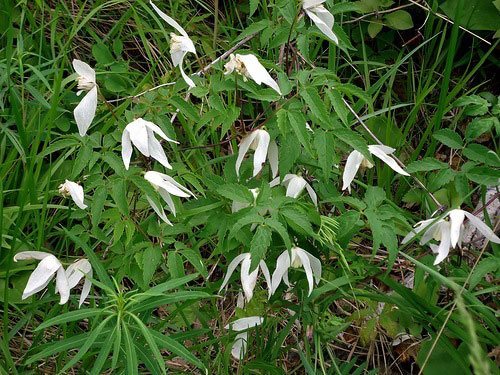

The stalks of this prince rise along a support 3 m in height, braiding it with leaf stalks. The flowers of the Siberian prince are large, in the form of a wide drooping bell, with white sepals. At the end of flowering, the Siberian prince does not lose its decorative effect, because interesting fruits appear on the plant.
Grand Duchess
The homeland is the Far East, Eastern Siberia, Korea, China, where it grows on the forest edges of deciduous and coniferous forests.
The flowers of the large-petaled prince consist of 4 oblong, covered with blue-purple sepals and innumerable linearly shaped bluish-purple petals of almost the same length as the sepals.
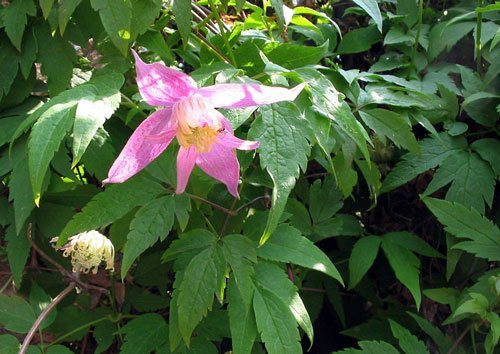

The large-flowered prince begins to bloom in May, and the fruits ripen in July. The prince is multiplied by seeds and cuttings.
There are many varieties bred in Canada. Varieties with different color of flowers were bred from it.
‘Estrella’ - liana 4 m in height, blue flowers, drooping. Blooms on last year's shoots. Winter-hardy.
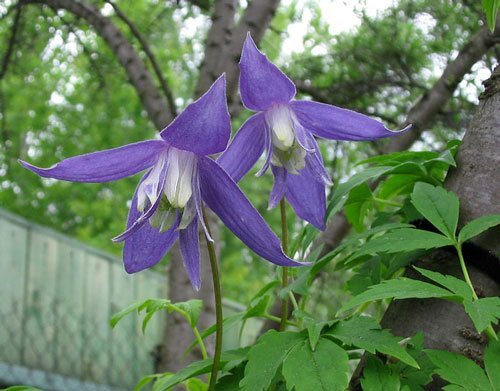

‘Memm’ - liana height 3 meters, flowers with a double corolla, white, drooping. Blooming on last year's shoots.
Varieties of princes
There are over a hundred varieties of clematis. The princes, along with clematis, are able to decorate any garden. The most common types are:
- Alpine with purple flowers and a bud size of about 6 centimeters. It is known for its recurring autumn blooms. It is one of the first varieties from which other species with different shades were bred.
- Okhotsk. The most cold-resistant species. Flowers differ in that they have up to 8 petals.
- Siberian. It begins to bloom by mid-summer in small flowers up to 4 centimeters in size. This is a very unpretentious species that can take root both in a sunny place and in the shade. Inflorescences of white or yellow shades attract bees with their delicate aroma.
- Large-petaled. The care of this variety is more demanding. Does not tolerate frost, flowers must be wrapped for the winter.It has very beautiful blue inflorescences that begin flowering a week later than the Alpine. Prefers an extremely sunny location.
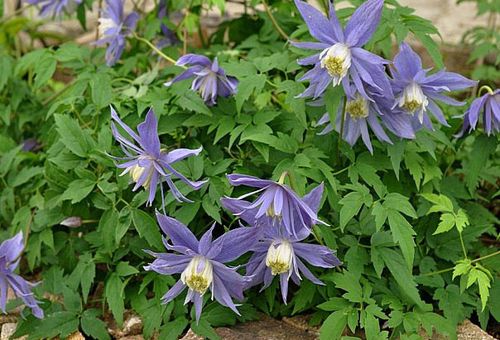

Large-petalled prince
They bloom for about 3 weeks. First, the Alpine prince begins to bloom, then the Okhotsk and, last of all, the Siberian. Planting these varieties together will create unique long-flowering compositions, and care behind them does not take much time and effort.
Some varieties of princes were brought to our country from Canada, having delicate shades of lilac, pink, white and purple-violet. These are Markham's Pink, Rosie Ogredi, Teige Landell, White Columbine. They are adapted to the conditions of central Russia and are winter-hardy species. On sale they can be found under the name "Clematis".
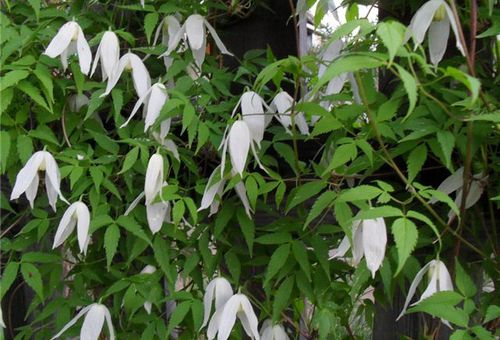

Prince Siberian
Useful properties and contraindications
Only the Siberian prince has healing properties. Its alcoholic tincture, extract or dried flowers and shoots are sold in pharmacies. Fresh plant is not used.
Preparations based on it are considered antineoplastic agents. They also have regenerating, tonic and antibacterial properties.
Decoctions and infusions are prepared from dry raw materials, which improve the work of the cardiovascular system, metabolism. They help with inflammation of the gastric mucosa and relieve headaches.
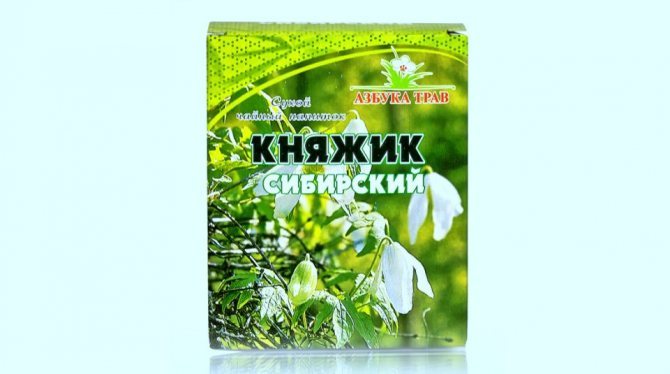

Herbal tea drink from Siberian prince
Since the prince is a poisonous plant, then before using it, you must consult a doctor and then withstand the dosage of the medicine. Strictly contraindicated in pregnancy, cardiac arrhythmias - extrasystoles and tachycardia.
The use of the prince
The princes are used for vertical gardening. Transparent, lightweight, beautiful and comfortable supports enhance the effect and emphasize the dignity of the plants. On the supports, the princes look like flowering hanging carpets. When planting, curly princes do not take up much space and can be planted where it is impossible to plant shrubs or trees.
Family: labiate. Form: herbaceous plant. Homeland of Monarda: North America. Description Monarda is a perennial plant, which is a beautiful dense bushes about 70 cm high. Stems are rigid, tetrahedral, hollow. The leaves of the monarda are oval-lanceolate, opposite, on small ...
Gardener's calendar for June
June 1 Loosen the soil, weed the weeds in the unmulched tree-trunk circles of fruit plants and the aisles of the garden, and if you haven't done this earlier, spray garden plants against diseases and pests, feed them with mineral or organic ...
Garden violet
The garden violet is a perennial herb, cultivated as a biennial. The leaves are arranged in sequential order or collected in a basal rosette. The violet has white, yellow, blue, red flowers. In Russia, the garden violet is more common ...
A plant from the barberry family, uncommon in horticultural culture, grows naturally in North America, in East Asia. Only 10 species are known, they have 2 thyroid leaves and several flowers. Young foliage of podophyllum ...
Botanical characteristic
The princes are known by names such as wild hop, loach, branch. Scientifically, the plant is called atragene, belongs to the buttercup family and is a subspecies of the genus clematis.
This vine grows to a length of about three meters. Stems "crawl" on vertical surfaces or recumbent. Leaves with elongated petioles are opposite.
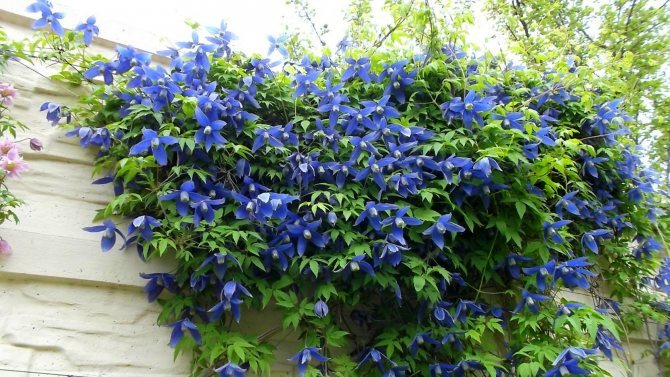

The prince trudging along the fence
The flowers are large - 10–12 cm in diameter, solitary, bell-shaped - lowered downward. The color palette is varied. Depending on the type and variety, there are plants with monochromatic flowers: white, blue, pink, purple, lilac or two-colored.
Distinctive features
The characteristic features of the plant include:
- the average length of the vine is from 2 to 3 m;
- large drooping bell-shaped buds;
- compound leaves of the opposite type, attached to elongated cuttings.
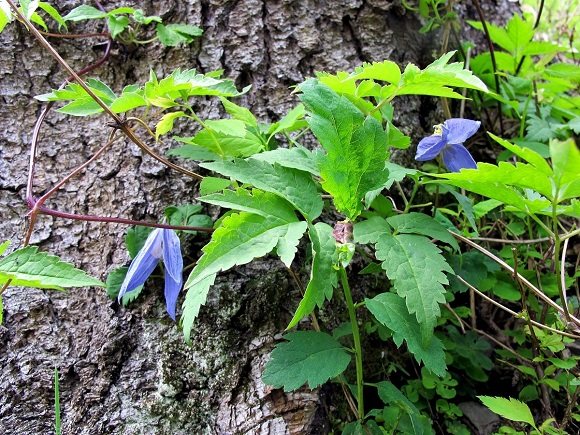

Wood as a support
Variable phenotypic traits are:
- double or simple bud shape;
- bicolor, white, pink, blue, violet, lilac, purple petals;
- there are 4 to 8 sepals in the calyx.
In nature, 8 species of princelings have been registered, several of them grow on the territory of Russia. Of the imported varieties, Alpine clematis is especially popular. The prince's endurance, uncharacteristic for most clematis, has become the reason that many growers compare it to hops. The plant is popularly known under such common names as wild or upland hops. Outwardly, they are so similar that it is difficult to distinguish them in the photo. Previously, the prince was called atragen in the Latin manner.
Plant pruning
Pruning clematis is a mandatory procedure. It prolongs flowering, allows you to give the plant a well-groomed appearance and beautiful shape. The procedure should be performed in early spring or before wintering. You need to choose a cloudless and dry day.
Pruning methods are directly related to the age of the plant. So:
- 1 Prince Alpine 1 year of life is cut off completely, all shoots are shortened by 25 cm. It is important to ensure that 2 buds remain on each stem. This is necessary in order to create additional vines. In the next season, the bush will be much more lush.
- 2C of older clematis, you need to remove all broken, diseased and dried shoots. Healthy stems are shortened by 10 cm.
There is also a universal method suitable for all plants, without exception. It involves pruning the bushes according to the principle through one: 1 stem is shortened in half, and 2 is cut so that only 2 buds remain on it. This is done with the whole plant. As a result, next season it looks much more well-groomed and lush.
Caring for the prince
Caring for the culture is quite simple, so this type is also suitable for novice summer residents. The plant is unpretentious and does not require any special conditions. During the summer cottage, it is necessary to carry out at least three dressings with mineral and organic fertilizers.
This is done alternately - from the beginning of growth to the formation of buds. In the soil prepared in advance, the prince can not be fed in the first year of life.
Pruning is carried out as the shoots grow back and dry out. This procedure must be carried out in the spring to form a bush, and during the summer you only need to remove damaged and dry stems.
In the garden, the plant can grow at will, but if it is a decoration of the front door, it needs to be shaped regularly. The lower part of the stems can be shaded by planting a hosta plant at a distance of 50 cm from the vine.

